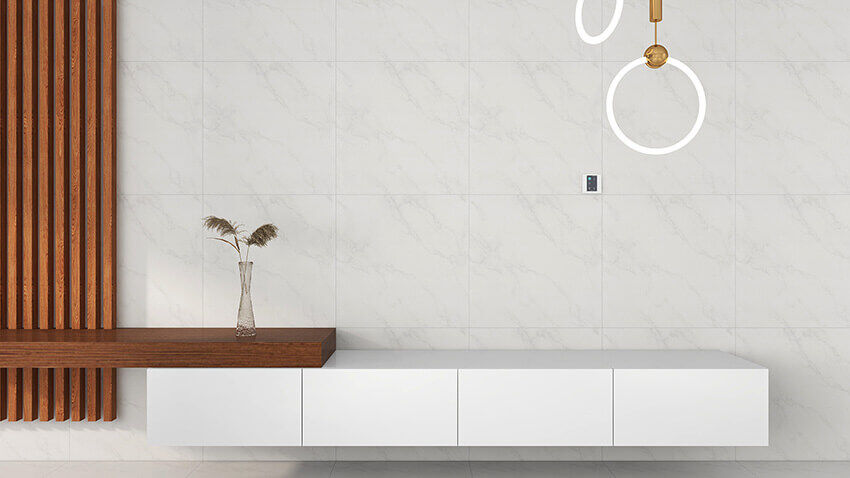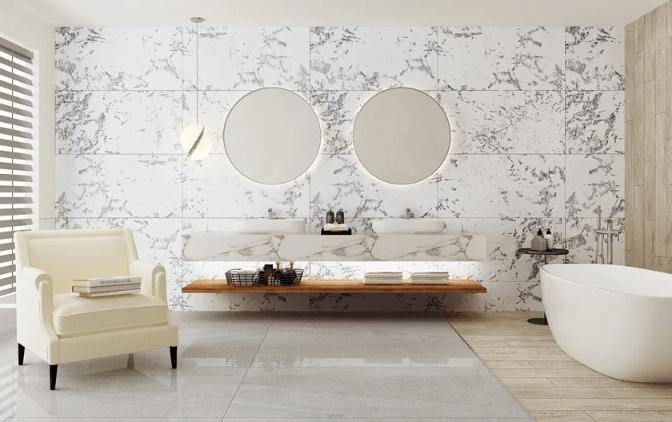
When it comes to designing a bathroom, choosing the right materials is essential for both aesthetics and functionality.
One material that has gained popularity over the years is porcelain tile. Renowned for its durability, versatility, and timeless appeal, porcelain tiles are an excellent choice for bathroom spaces.
In this post we'll explore the key considerations for using porcelain tiles in your bathroom, helping you make an informed decision about this fantastic option.
Porcelain tiles are an excellent choice for bathroom flooring and wall coverings for several reasons. Firstly, they are incredibly durable and can withstand the daily wear and tear that bathrooms endure.
Porcelain is fired at a high temperature, making it dense and less porous, which means it is resistant to moisture and stains, a crucial attribute for bathroom use.
Additionally, porcelain tiles come in various styles, colors, and textures, allowing you to achieve your desired aesthetic, whether it's a sleek, modern look or a more traditional feel.

Porcelain and ceramic tiles are often used interchangeably, but they do have some differences that may affect your bathroom project.
Porcelain tiles are denser and less porous than ceramic tiles, making them more water-resistant and suitable for bathroom applications.
If you live in a region with extreme temperature variations, porcelain is also a better choice because it is less prone to cracking due to temperature changes.
However, ceramic tiles can be a more cost-effective option for those on a tight budget.
One common concern with bathroom tiles is slipperiness, especially when they get wet.
Porcelain tiles come in various finishes, and you can choose one that suits your preferences and safety concerns.
Matte or textured finishes provide more traction, making them less slippery, which is ideal for bathroom floors.
Polished porcelain tiles, while visually appealing, may be more slippery when wet, so it's crucial to consider the location and purpose of the tile when making your selection.
Additionally, using bath mats or rugs in areas where water is frequently splashed can enhance safety.

Porcelain Tiles for Living Room
One of the advantages of porcelain tiles is their natural resistance to moisture and stains. Unlike some other materials, porcelain tiles do not require sealing to maintain their water-resistant properties.
The non-porous surface of porcelain tiles makes them inherently resistant to moisture penetration, which is essential in a bathroom where water exposure is constant.
This low maintenance aspect of porcelain tiles can save you time and effort in the long run.
Water seepage is a concern in bathrooms, but it's less likely to occur with porcelain tiles due to their low porosity.
When properly installed, porcelain tiles form a watertight barrier that prevents water from seeping through the tiles and damaging the underlying structure.
However, it's crucial to ensure that the tiles are installed correctly, with proper grouting and sealing around fixtures and joints to maintain their water-resistant properties.

Porcelain tiles are an excellent choice for bathrooms, offering durability, versatility, and aesthetic appeal.
Whether you opt for a matte or textured finish for slip resistance or a polished look for added elegance, porcelain tiles can enhance the beauty and functionality of your bathroom.
Moreover, their natural resistance to moisture and stains makes them a low-maintenance option, and when installed correctly, they provide a reliable barrier against water seepage.
So, if you're considering a bathroom renovation or designing a new one, porcelain tiles should undoubtedly be on your list of top choices for a long-lasting and beautiful bathroom space.